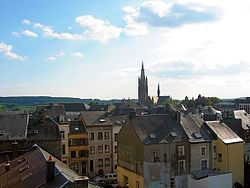Arrondissement Arlon Area 118.6 km² | Postal codes 6700, 6704, 6706 Local time Wednesday 2:54 PM | |
 | ||
Weather 6°C, Wind SW at 21 km/h, 92% Humidity Points of interest Musée Archéologique, Musée Gaspar, Église Saint‑Donat d'Arlon, Tour Romaine | ||
Arlon fortunate official music video directed by karizma visuals
Arlon ([aʁlɔ̃]; Luxembourgish: Arel; Dutch: Aarlen, [ˈaːrlə(n)]; German: Arel; Walloon: Årlon) is a Walloon municipality of Belgium located in and capital of the province of Luxembourg. With a population of just over 28,000, it is the smallest provincial capital in Belgium. Arlon is also the capital of its cultural region : the Arelerland (Land of Arlon in Luxemburgish).
Contents
- Arlon fortunate official music video directed by karizma visuals
- Map of 6700 Arlon Belgium
- Arlon fortunate
- Roman and medieval times
- 15th century until the French Revolution
- Modern times
- Arlon today
- Sights
- Local customs
- Politics
- People born in Arlon
- Twin towns sister cities
- References
Map of 6700 Arlon, Belgium
The municipality consists of the following sub-municipalities: Arlon proper, Autelbas-Barnich, Bonnert, Guirsch, Heinsch, and Toernich. Other population centers include:
Arlon fortunate
Roman and medieval times
Before the Roman conquests of Gaul, the territory of Arlon and a vast area to the southeast were settled by the Treveri, a tribe of mixed Celtic and Germanic origins. The local population adapted relatively easily to Roman culture. The number and quality of sculpted stones and monuments that have been unearthed in the area demonstrate that the vicus of Orolaunum quickly became a vibrant commercial and administrative centre of Roman civilization. The Germanic invasions of the 3rd century destroyed most of these early advances, despite the defensive walls that had been built on the Knipchen hill to protect the vicus.
During most of the Middle Ages, the population still used the earlier buildings such as the thermae. In 1060, Waleran I of Limburg, Count of Arlon, built a castle on the Knipchen hill. In the 13th century, the only women's Cistercian abbey known to date was built in Clairefontaine.
15th century until the French Revolution
The Duchy of Luxembourg itself, of which Arlon was dependent, became part of the Burgundian Netherlands under Philip the Good in 1441. After Charles V's abdication of his empire to his son Philip II of Spain in 1556, a troubled period started for the whole region as continuous wars opposed France, Spain, and the Southern Netherlands. In 1558, nearly half of the city, including its castle, was destroyed by the French troops of Duke François of Guise. In the 17th century, Capuchin monks built a convent on the ruins of the castle and the French strengthened the defensive walls according to Vauban's designs. An accidental fire destroyed a large part of the city again in 1785.
Modern times
On 9 June 1793 the French Revolutionary troops opposed the Austrians just outside Arlon. The French emerged victorious and occupied the city. They expelled the Capuchin monks and used their convent as a hospital. After the Battle of Waterloo, Arlon's history is entwined with that of Belgium.
Arlon was one of the first victims of the German invasion in 1914 as 121 inhabitants were executed on 26 August, on the orders of Colonel Richard Karl von Tessmar. Its territory was again among the first to be invaded at the onset of World War II. During the war, the mayor of Arlon, Paul Reuter collaborated with the occupying Germans. He was shot in 1946.
Arlon today
Being situated very close to the border with the Grand Duchy of Luxembourg, Arlon has continued to expand with new residential areas and commercial development zones, and many people cross the border everyday to work in the Grand Duchy. One of the largest industrial employers is the Ferrero Rocher chocolate factory. All International express trains make a stop in Arlon, as it is the last station on the main Brussels—Luxembourg City railway line.
Sights
Local customs
Politics
List of mayors :
People born in Arlon
Twin towns — sister cities
Arlon is twinned with:
